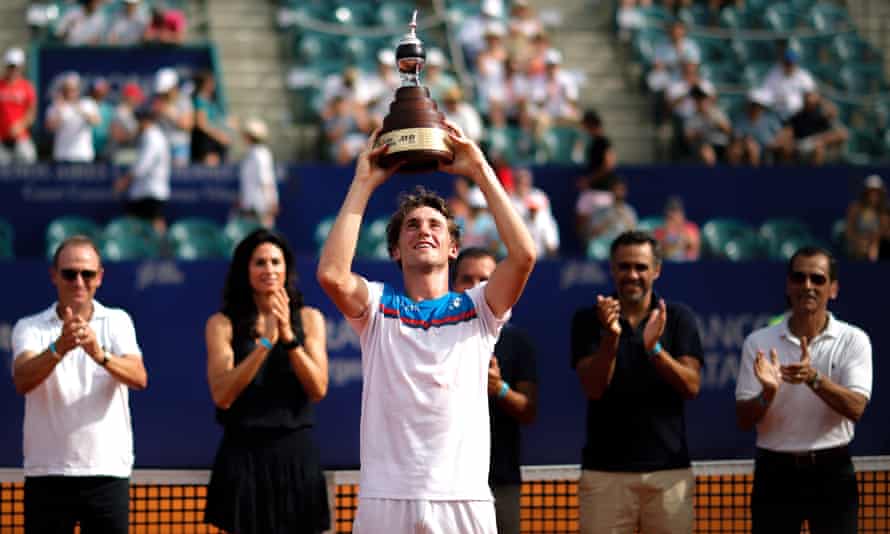Shortly after Wimbledon, during an interminable July in world sport, many top players packed their bags and headed off to Tokyo for the Olympic Games. But not everyone. Some were unable to qualify for the event, while others detested the restrictive conditions in Japan.
And then there were players, such as the 22 year-old Casper Ruud, who saw an opportunity and took it with aplomb. With all eyes on Tokyo, Ruud quietly won consecutive ATP 250 titles in Bastad, Gstaad, and Kitzbühel. This was already a breakout top-20 year for him, but those results pushed him into the conversation for an ATP Finals spot, where he will compete for the first time in Turin next week.
Ruud is an anomaly at the top levels of tennis. Norway’s previous highest-ranked men’s player peaked at 39th in 1995 and the country remains such a non-entity beyond him that Ruud competes in the lower divisions of the Davis Cup, even facing unranked non-professionals there. From Ruud’s perspective, tennis does not receive sufficient attention or finances, and in a winter sport country, it is difficult to change that.
“It’s always easier to blame the federation for these things but it’s tough for the federation,” says Ruud. “Because they don’t receive too much money from the government to put in a lot of money, making new courts, new centres, new academies to make new players. That’s the biggest struggle in Norway. Most of the money doesn’t go to tennis.”
It just so happens that the previous highest-ranked Norwegian player was his father. It was Christian Ruud who first put a racket into Casper’s hands and he has remained his son’s coach ever since. It has gone fairly well; Ruud went on to become a junior No 1 and is now ranked world No 8. He considers his father’s experience essential to his success.
“Even though over the last years I’ve had more and more success and I’ve been getting better on the tour, I think I’ve lived this kind of life as an athlete for many years already,” he says. “My father has been serious with me because he wanted me to have the best opportunities to do well. I think that has been a huge benefit for me coming from a small country like Norway.”

While Ruud’s junior career was actually propelled by hardcourt success, as a professional he has thrived on clay. Ruud grinds opponents down with his spin and physicality, while his vicious, heavy forehand is most lethal on the dirt. That forehand alone is underrated in its excellence, a shot that generates one of the highest spin rates and also troubles opponents by bouncing uncomfortably high.
It was not always this way. Ruud laughs as he reminisces back to when he faced his friend Mikael Ymer of Sweden at the under-14 European Championship and neither player could even crack an egg with their forehands, resulting in endless moonball rallies. Now standing at 6ft, Ruud is the smallest qualifier in Turin, but has grown into a solid frame and the early influence of Rafael Nadal is far more visible in his game.
“Watching Nadal, who was my favourite player growing up, I think that also made a small impact on the way I tended to play because when you’re young it’s always fun to, not imitate, but try to learn from your favourite players,” he says. Then he laughs. “Growing up, I’ve figured it was maybe not the best thing to try to copy Nadal’s style because he’s very physical.”
As Ruud has risen up the rankings, he has unwittingly become part of some age-old tennis debates. The first is what some fans call “vulturing”, which is a pejorative for when quality players enter weaker tournaments and gain points by beating lower-ranked players, as in the summer when Ruud’s highest ranked opponent in his trio of titles was No 49. In truth, all he did was follow a schedule according to his strengths and benefit from his convincing performances.
Similarly, players who prefer clay are often stigmatised in a way that specialism on other surfaces is not, even though no surface is more superior than the other and the prevalence of hard courts in the modern game is primarily down to cost and convenience. Ruud is well aware of how some view him, not least thanks to numerous jibes on social media from Nick Kyrgios. He admirably takes it in his stride, with some humour, and offers a diplomatic response on the subject.
“It goes both ways,” he says. “You have clay players that have maybe struggled doing as well on hard courts and those will get criticised. But you also have hard court players or grass players who maybe struggle doing well on clay, and that will always be the case. You can argue whether one surface is better than the other, everyone will have their opinion and that’s fine, but in my opinion I prefer the clay both to play and to watch matches on.”
While Ruud may not be as effective on other surfaces where “more competitors can hit me off the court”, he is only 22 and improving. This summer he won a ATP 250 title on hard courts in San Diego and has finished the year with a series of solid results both outdoors and indoors. He is the youngest ATP Finals qualifier this year, and his lofty success in his short career has led to him taking a seat at the top table in Turin even quicker than many anticipated. It will not be his last time there.




